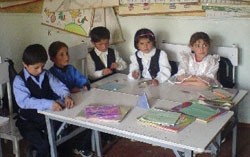
The village of Yazgulam in Gorno Badakhshan District was one of the hotbeds of Tajikistan’s civil war from 1992 to 1997. Although the war ended years ago, Yazgulam’s inhabitants were still afraid of the militants that continued to wander around the village. “Safety was the main concern. I didn’t have high hopes that this place would ever improve,” said resident Khafiz Azoraev.
Education was not a priority for this community, so USAID selected Yazgulam’s School No. 22 as one of the district’s 18 core schools to receive assistance. With 279 students in Grades 1 to 11 and 20 teachers, School No. 22 was to become a model and resource center for education improvement for the area.
USAID’s project provided teacher and administrator training, books and teaching materials for creating a learning resource center, assistance in community mobilization and parent involvement, and a small grant for classroom repairs. Teachers were taught to build lessons around their students, in order to promote critical thinking, analysis, self-assessment, self-reflection, and teamwork. Rearranging desks in clusters instead of rows, letting children talk while solving a problem, using visual teaching aids, and making sure everyone stayed engaged in their assignments (done in groups rather than individually) were just a few of the changes that took place in the classroom.
Three years into its partnership with USAID, the school has transformed into a buoyant community center. “It’s completely different now,” said Khafiz, the parent-teacher association chairman. While the project initially focused on primary school teachers, soon all teachers in the school wanted to use the new techniques.
Following the project’s advice, the school established a non-budget fund, which accumulates community contributions that are used for school development needs, and became the first in the entire district to have designed a 5-year School Development Strategy. Most importantly, the school hasn’t had grade repetitions in three years and for the first time, its graduates entered universities recently.







Comment
Make a general inquiry or suggest an improvement.